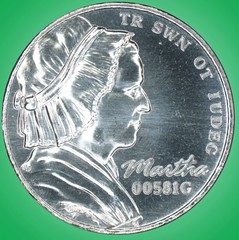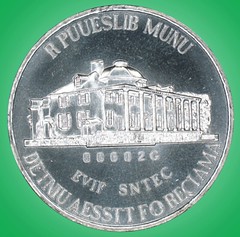
PREV ARTICLE
NEXT ARTICLE
FULL ISSUE
PREV FULL ISSUE
Only an engineering geek like me would say this, but I'm a big fan of the National Institute of Standards and Technology
(NIST). It's probably the most important government agency you've never heard of. From their website: "As industry’s national
laboratory, NIST is dedicated to supporting U.S. competitiveness in areas of national importance from communications technology and cybersecurity to
advanced manufacturing and disaster resilience."
So what do they have to do with numismatics? You're about to find out. -Editor   When designing a new coin, U.S. government agencies such as NIST use a "dummy" imprint so as not to run afoul of anti-counterfeiting rules. Here, Martha Washington in a mob cap subs in for Thomas Jefferson. Nickels are ubiquitous in American life, tumbling around in pockets, rolling under car seats, and emerging from the back of dryers to be used over and over for countless purchases. But these resilient and somewhat humble-looking coins are also becoming costly to produce. Nickel, the coin’s own namesake, has become a prized ingredient in many modern products, pushing the market value so much that sometimes making the five-cent coin costs as much as seven cents a pop. Working in conjunction with the U.S. Mint, a research team at the National Institute of Standards and Technology (NIST) has identified an alternative approach that would reduce the cost of materials for the nickel by as much as 40 percent. This approach would produce a coin every bit as tough and reliable as the old nickel but also every bit as familiar to the American citizen. The paper that details the work was published today in the journal Integrating Materials and Manufacturing Innovation. As an added benefit, the data from this research has also produced results that may aid high-tech companies looking for new materials to use in resilient electronics such as phones and laptops, and in a variety of radical new colors, to boot. The manufacturing of coins is a complicated and demanding process. Coins must not corrode in the palm of a moist hand, for example. The images stamped on their faces must be resilient enough to withstand decades of commerce and the occasional turn through the laundry. Their metallic sheen must always be recognizable, and of uniform thickness and density. Although invisible to the average customer buying a gumball or a soda, all U.S. coins must also contain a predetermined amount of electrical conductivity to work in vending machines, which use a small meter to determine a coin’s currency signature. A parking meter or soda machine won’t count your nickel without this key characteristic. In many ways the nickel-production challenge was an ideal match for the NIST Materials Genome Initiative (MGI), which was started in 2011 with the ambitious goal of decreasing the time it takes a new material to reach market by at least half while keeping costs low. The MGI has been building the computational and IT tools needed for the development of all kinds of new materials for use in a wide variety of manufacturing applications. “Rethinking the nickel was one of the first times we were able to deploy the new MGI tools to design a material for a specific application,” said NIST scientist Carelyn Campbell. “We were very pleased with the results.” The NIST team worked backward, first identifying the desired qualities for the new nickel piece and then figuring out what alloys and procedures might be needed to make it a reality. The U.S. Mint also outlined some site-specific constraints; namely, the new coin had to be produced using the existing manufacturing facilities in Denver and Philadelphia, both of which use a specific type of slow-cooling procedure. Color proved particularly challenging. Although most people would not think of the coin as having a special tone or hue, coin collectors are a demanding group and will often reject coins that are even slightly off-tone, and collectors form a significant share of the market for money pieces. The general public also might not trust a coin that is too orange or too yellow. But color is often a subjective criterion, and one that can be hard to quantify or reproduce with any kind of reliable standard. In this case, the use of the MGI process proved enormously helpful—surprising even the researchers themselves with how efficient the outcome was. Starting with the set of parameters for resilience, conductivity and color, the team was able to produce a new mix of copper, nickel and zinc that was 40 percent less expensive than the previous metal mix. The results could potentially save the U.S. Mint millions. In addition, several companies that manufacture high-tech items have shown an interest in the results, since there’s a strong consumer demand for electronics that are durable but also available in a variety of colors such as metallic pink. No word yet on whether anyone is actively pursuing a phone that can make it through a turn in a hot dryer on laundry day, though. To read the complete article, see: Wayne Homren, Editor The Numismatic Bibliomania Society is a non-profit organization promoting numismatic literature. See our web site at coinbooks.org. To submit items for publication in The E-Sylum, write to the Editor at this address: whomren@gmail.com To subscribe go to: https://my.binhost.com/lists/listinfo/esylum All Rights Reserved. NBS Home Page Contact the NBS webmaster 
|